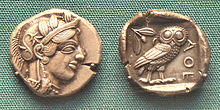Silver mining: Difference between revisions
No edit summary |
|||
| Line 74: | Line 74: | ||
*[[Silver mining in the United States]] |
*[[Silver mining in the United States]] |
||
==References== |
⟨⟩==References== |
||
{{reflist}} |
{{reflist}} |
||
Revision as of 14:19, 7 December 2012
Silver mining refers to the resource extraction of the precious metal element silver by mining.
History


Silver has been known since ancient times. It is mentioned in the Book of Genesis, and slag heaps found in Asia Minor and on the islands of the Aegean Sea indicate that silver was being separated from lead as early as the 4th millennium BCE. The silver mines at Laurium were very rich and helped provide a currency for the economy of Ancient Athens. It involved mining the ore in underground galleries, washing the ores and smelting it to produce the metal. Elaborate washing tables still exist at the site using rain water held in cisterns and collected during the winter months.
Extraction of silver from lead ore was widespread in Roman Britain as a result of Roman mining very soon after the conquest of the first century CE.
From the mid-15th century silver began to be extracted from copper ores in massive quantities using the liquation process creating a boost to the mining and metallurgy industries of Central Europe.
Vast amounts of silver were brought into the possession of the crowns of Europe after the conquest of the Americas from the now Mexican state of Zacatecas (discovered in 1546)[1] and Potosí (Bolivia, also discovered in 1546), which triggered a period of inflation in Europe. The conquistador Francisco Pizarro was said to have resorted to having his horses shod with silver horseshoes due to the metal's abundance, in contrast to the relative lack of iron in Peru. Silver, which was extremely valuable in China, became a global commodity, contributing to the rise of the Spanish Empire. The rise and fall of its value affected the world market.
Modern era
Silver mining was a driving force in the settlement of western North America,[2] with major booms for silver and associated minerals (lead, mostly) in the galena ore silver is most commonly found in. Notable silver rushes were in Colorado; Nevada; Cobalt, Ontario; California and the Kootenay region of British Columbia; notably in the Boundary and "Silvery" Slocan. The first major silver ore deposits in the United States were discovered at the Comstock Lode in Virginia City, Nevada, in 1859.
In the first half of the 19th century Chilean mining revived due to a silver rush in the Norte Chico region, leading to an increased presence of Chileans in the Atacama desert and a shift away from an agriculture based economy.
Areas

Silver is found in native form very rarely as nuggets, but more usually combined with sulfur, arsenic, antimony, or chlorine and in various ores such as argentite (Ag2S) and chlorargyrite ("horn silver," AgCl).
The principal sources of silver are copper, copper-nickel, gold, lead, and lead-zinc ores obtained from Canada, (such as Cobalt, Ontario); Mexico (such as Batopilas); Poland; Peru; Bolivia; Australia; and the United States.
Mexico was the world's largest silver producer in 2010. According to the Silver Institute, it produced 128.6 million troy ounces (3,999 metric tons) in 2010, about 17 percent of the annual production of the world.[3] In 2010, total global mine production of silver was approximately 735 million troy ounces.[4][5]
| Mine | Country | 2010 Production |
|---|---|---|
| Cannington Silver/Lead/Zinc Mine | Australia | 38.6 Moz |
| Fresnillo Silver Mine | Mexico | 38.6 Moz |
| San Cristobal Polymetallic Mine | Bolivia | 19.4 Moz |
| Antamina Copper/Zinc Mine | Peru | 14.9 Moz |
| Rudna Copper Mine | Poland | 14.9 Moz |
| Peñasquito Polymetallic Mine | Mexico | 13.9 Moz |
| Project | Country | Anticipated Annual Production Capacity (due within five years) |
|---|---|---|
| Pascua Lama | Chile | 25.0 Moz |
| Navidad | Argentina | 15.0 Moz |
| Juanicipio | Mexico | 14.0 Moz |
| Malku Khota | Bolivia | 13.2 Moz[8] |
| Hackett River | Canada | 13.1 Moz |
| Corani | Peru | 10.0 Moz |
Ore processing

Silver is commonly extracted from ore by smelting or chemical leaching. Ore treatment by mercury amalgamation, such as in the patio process or pan amalgamation was widely used through the 1800s, but is seldom used today.
Silver is also produced during the electrolytic refining of copper and by application of the Parkes process on lead metal obtained from lead ores that contain small amounts of silver. Commercial grade fine silver is at least 99.9 percent pure silver and purities greater than 99.999 percent are available.
See also
⟨⟩==References==
- ^ Dan Oancea: Low Sulphidation Epithermal Vein Deposits http://technology.infomine.com/articles/1/546/silver.sulphidation.epithermal/silver.deposits.–.aspx
- ^ Dan Oancea: Silver Deposits - Carbonate Replacement Deposits http://technology.infomine.com/articles/1/693/silver.deposits.crd/silver.deposits.carbonate.aspx
- ^ Klapwijk, Philip (2011). World Silver Survey. London, UK: GFMS Limited. p. 24. ISBN 978-1-880936-19-1.
- ^ CPM Group (2011). The CPM Silver Yearbook 2011. New York, NY: Euromoney Books. p. 67. ISBN 978-0-9826741-4-7.
- ^ The Silver Institute (2011). World Silver Survey 2011. London, UK: GFMS Limited. p. 8. ISBN 978-1-880936-19-1.
- ^ CPM Group (2011). The CPM Silver Yearbook 2011. New York, NY: Euromoney Books. p. 68. ISBN 978-0-9826741-4-7.
- ^ CPM Group (2011). The CPM Silver Yearbook 2011. New York, NY: Euromoney Books. p. 74. ISBN 978-0-9826741-4-7.
- ^ "43-101 Preliminary Economic Assessment Technical Report Malku Khota" (PDF). South American Silver Corp. Retrieved July 26, 2011.
